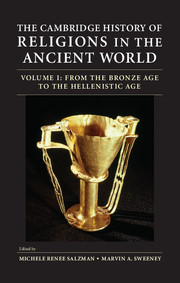Book contents
- Frontmatter
- Contents
- List of Figures and Maps
- List of Contributors
- List of Abbreviations
- Acknowledgments
- Introduction to Volumes I and II
- Introduction to Volume I
- Part I Mesopotamia and the Near East
- Part II Egypt and North Africa
- Part III Greece and the Eastern Mediterranean
- Part IV The Western Mediterranean and Europe
- Suggestions for Further Reading
- General Index
- Index of Citations
- Frontmatter
- Contents
- List of Figures and Maps
- List of Contributors
- List of Abbreviations
- Introduction to Volume II
- Part I Iran and the Near East
- Part II Egypt and North Africa
- Part III Greece and Asia Minor
- 11 Religions of Greece and Asia Minor
- 12 Judaism in Asia Minor
- 13 Christianity in Asia Minor
- Part IV Italy, Roman Gaul, and Spain
- Suggestions for Further Reading
- General Index
- Index of Citations
- References
13 - Christianity in Asia Minor
Observations on the Epigraphy
from Part III - Greece and Asia Minor
Published online by Cambridge University Press: 05 October 2013
- Frontmatter
- Contents
- List of Figures and Maps
- List of Contributors
- List of Abbreviations
- Acknowledgments
- Introduction to Volumes I and II
- Introduction to Volume I
- Part I Mesopotamia and the Near East
- Part II Egypt and North Africa
- Part III Greece and the Eastern Mediterranean
- Part IV The Western Mediterranean and Europe
- Suggestions for Further Reading
- General Index
- Index of Citations
- Frontmatter
- Contents
- List of Figures and Maps
- List of Contributors
- List of Abbreviations
- Introduction to Volume II
- Part I Iran and the Near East
- Part II Egypt and North Africa
- Part III Greece and Asia Minor
- 11 Religions of Greece and Asia Minor
- 12 Judaism in Asia Minor
- 13 Christianity in Asia Minor
- Part IV Italy, Roman Gaul, and Spain
- Suggestions for Further Reading
- General Index
- Index of Citations
- References
Summary
Asia Minor is one of the few areas of the Mediterranean where the continuous development of Christianity can be traced from the first century CE. Apart from Rome, other regions are by comparison devoid of specific literary references to the physical layout of Christian communities, the trades they practiced, their position in local social strata, and their interactions with non-Christians, excluding of course those with imperial and provincial authorities in times of sporadic persecution.
For a long time, the ecclesiastical histories of Eusebius and his successors provided the basic evidence for Asia Minor. Starting with the last decades of the nineteenth century, however, there began systematic exploration of the region for early Christian remains. Among the researchers to visit these sites were J. G. C. Anderson, William Mitchell Ramsay, and Ramsay’s students (among them W. H. Buckler and W. M. Calder). The latter took advantage of the construction of the Berlin-to-Baghdad railway to inspect parts of western and central Asia Minor that western scholars had seldom before seen. Some of this research was embodied in Ramsay’s monumental The Cities and Bishoprics of Phrygia. Their work, and that of teams of German scholars, resulted in the publication of the ten-volume Monumenta Asiae Minoris Antiqua, which contains editions of inscriptions and discussion of literary conventions. A comprehensive edition of the early Christian inscriptions of Asia Minor remains, however, a desideratum; many important editions and commentaries still lie buried in volumes of collected articles and back issues of journals. Synthetic treatments of the subject have often been disappointing in their results and at times controversial. An example of this can be seen in unsuccessful attempts to find Montanist nuances in the “Christians for Christians” inscriptions and other texts.
- Type
- Chapter
- Information
- The Cambridge History of Religions in the Ancient World , pp. 341 - 368Publisher: Cambridge University PressPrint publication year: 2013



